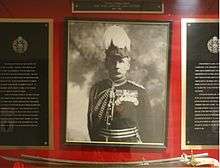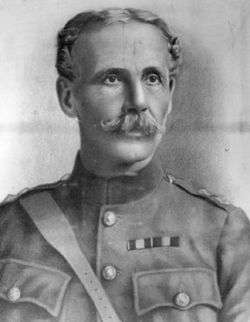William Dillon Otter
| Sir William Dillon Otter | |
|---|---|
|
William Dillon Otter in 1900 | |
| Born |
December 3, 1843 The Corners, Canada West |
| Died |
May 5, 1929 (aged 85) Toronto, Ontario |
| Allegiance | Canada |
| Service/branch | Canadian Army |
| Years of service | 1866–1902 |
| Rank | General |
| Commands held |
Chief of the General Staff Royal Canadian Regiment of Infantry |
| Battles/wars | |
| Awards |
Knight Commander of the Order of the Bath Commander of the Royal Victorian Order Volunteer Officers' Decoration |
General Sir William Dillon Otter, KCB, CVO, VD (December 3, 1843 – May 6, 1929) was a professional Canadian soldier who became the first Canadian-born Chief of the General Staff, the head of the Canadian Militia.
Military career
Otter was born near The Corners, Canada West. His parents were Anna Louisa, née de la Hooke (1824–1907) and Alfred William Otter (1815–1866),[1] both English immigrants who married in Ontario on 15 September 1842. He began his military career in the Non-Permanent Active Militia in Toronto in 1864. Captain William Otter was Adjutant of the Queen's Own Rifles of Toronto in 1866. He first saw combat with them at the Battle of Ridgeway during the Fenian Raids.
He joined the Permanent Force as an infantry officer when Canada established its own professional infantry unit in 1883. On May 2, 1885, he led a Canadian force of more than 300 in the Battle of Cut Knife against Poundmaker's Cree Indians. Otter's tactics were ineffective against the defending warriors, forcing him to retreat.
In 1890, Otter founded the Royal Canadian Military Institute as a body for "the promotion and fostering of military art, science and literature in Canada." The Gen Sir William Otter Papers are selected from those presented at events organized by the Defence Studies Committee of the Royal Canadian Military Institute.[2]
He was appointed as the first Commanding Officer of the Royal Canadian Regiment of Infantry in 1893.
Lieutenant Colonel Otter commanded the Royal Canadian Regiment of Infantry at the time of the Second Boer War, during which he played an important part in the Battle of Paardeburg. Otter commanded the 2nd (Special Service) Battalion of The Royal Canadian Regiment of Infantry in South Africa, where they were considered by many British officers to be the best infantry battalion in the country. He became the first Canadian-born officer to command Canada's military in 1908, and he retired in 1910 as a full general. Otter had the reputation of being something of a martinet – due mainly to his desire that the young Canadian Army should not show up badly when compared to British troops.[3]
He wrote The Guide: A Manual for the Canadian Militia (Infantry) Embracing the Interior Economy, Duties, Discipline, Drills and Parades, Dress, Books, and Correspondence of a Battalion with Regulations for Marches, Transport & Encampment, Also Forms & Bugle Calls in 1914, which includes sections on discipline, courts martial, offences, complaints, and defaulters.
During the First World War he came out of retirement to command operations for the internment of enemy nationals resident in Canada.
Otter headed the Otter Commission. The Otter Commission was tasked to establish links of perpetuation from the units of Canadian Expeditionary Force back to the institutionally separate units of the Canadian Militia in the years following the First World War. This establishment of perpetuation, based primarily on geographical connections through original recruiting areas of the CEF battalions, provided a basis by which the achievements and battle honours of the CEF units transferred back to the units of the standing Militia. Without this work of the Otter Commission the CEF and its achievements would have had no continuance with existing units of the Canadian Army today.
General Sir William Otter died on 6 May 1929.
Freemason
Otter was initiated into the Ionic Lodge of Freemasonry in Toronto in February 1869. He became Worshipful Master in 1873.[4]
Legacy

Otter Squadron, composed of University Training Plan Non Commissioned Member Officer Cadets, at the Royal Military College of Canada in Kingston, Ontario, was named in his honour.
Family connections
Otter was the grandfather of Canadian Military historian Desmond Morton.
References
- ↑ The son of William Otter, Bishop of Chichester
- ↑ Gen Sir William Otter Papers
- ↑ Brian A Reid "Our Little Army in the Field – The Canadians in the Boer War"
- ↑ William Dillon Otter in Ionic Lodge
Further reading
- Desmond Morton, The Canadian General Sir William Otter, Toronto: Hakkert, 1974. Canadian War Museum historical publication
- Commander Chas. N. Robinson R.N., Celebrities of the Army, London: George Newnes Limited, 1900.
- Major-General Sir William D. Otter `The Guide: A Manual for the Canadian Militia (Infantry) Embracing the Interior Economy, Duties, Discipline, Drills and Parades, Dress, Books, and Correspondence of a Battalion with Regulations for Marches, Transport & Encampment, Also Forms & Bugle Calls` Toronto: Copp, Clark & Co. 1914
External links
- Biography at the Dictionary of Canadian Biography Online
- Information from civilisations.ca
- Information on Otter and the Otter Committee at canadiansoldiers.com
| Military offices | ||
|---|---|---|
| Preceded by Sir Percy Lake |
Chief of the General Staff (Canada) 1908–1910 |
Succeeded by Sir Colin Mackenzie |
